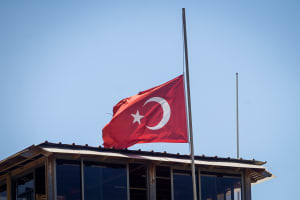World revival is coming

World revival is coming – but not a Christian revival. The future will see a world religion that exalts man and minimizes God. The Book of Revelation, chapter 17 describes the development and destruction of what John calls “Babylon the Great,” a blasphemous world religious system. Karl Marx was right when he called religion the opiate of the masses. He discovered the truth; that man is incurably driven to worship something, somewhere. If humans do not bow before the holy and true God, then they will devise their own method, their own system, their own god and they will worship their own creation.
While the coming world's religious system in some ways resembles Christianity, John calls it “Babylon the Great” – a monstrous, ecumenical combination of everything that people consider “spiritual.” And the world will buy into it – hook, line and sinker.
Mostly sinker.
In the Bible, harlotry consistently stands for one thing: idolatry. Whenever God’s people turned from the true and living God, or when any group of people worshipped anything other than God, the Bible consistently labeled it harlotry.
For example, at one point in Israel’s history, God asked Jeremiah, “Have you seen what backsliding Israel has done? She has gone up on every high mountain and under every green tree, and there played the harlot” (Jeremiah 3:6). The wayward people of Israel made it a habit to visit groves of false worship, where out of tree trunks they would carve statues to worship. And so God said, just a few verses later, “So it came to pass, through her casual harlotry, that she defiled the land and committed adultery with stones and trees” (v. 9).
The entire book of Hosea is built upon this metaphor of an unfaithful wife who plays the harlot. Just as Hosea repeatedly tried to reach his wayward wife, so God tried again and again to draw His people back to Himself; and yet Israel was consistently unfaithful to Him. She played the harlot by following other gods.
I find it interesting that Jesus would choose to use the metaphor of a woman for His Church. As the British novelist Mary Elizabeth Braddon asked in the late 1800s: “How are our churches beautified, our sick tended, our poor fed, our children taught and cared for and civilized?
Women are the church’s strong rock. As they were the last at the foot of the cross, so they have become first at the altar.”
So here in Revelation 17, we have a deeply unfaithful woman whom an angel calls “the great harlot.” She represents a religious system that claims to be joined to God but, like a prostitute, is unfaithful to God. Her sin is spiritual fornication, the sin of turning from God and refusing to remain spiritually faithful to Him.
The Coming World Leader
James had the same imagery in mind when he wrote to some church people, “Adulterers and adulteresses! Do you not know that friendship with the world is enmity with God?” (James 4:4). James rebuked them because they lusted after and coveted illicit pleasures, which sparked a series of fights within the church. They had allowed worldly things to replace God in their hearts. So James admonishes them, saying, “Listen, you simply can’t have an affair with the world. That’s adultery, and God won’t stand for it.”
God will always judge adultery and fornication, whether literal or spiritual. And He has a special judgment in store for the great harlot of Revelation 17.
The Roots of the System (Revelation 17:5)
The roots of this false religious system go far back in time, long before John wrote his book. John tells us the harlot had a name written on her forehead: “MYSTERY, BABYLON THE GREAT, THE MOTHER OF HARLOTS AND OF THE ABOMINATIONS OF THE EARTH” (v. 5).
Clear back in Genesis 10, a man by the name of Nimrod is mentioned (vv. 8-9). He is four generations removed from Noah; his grandfather was Ham, the wicked son of Noah. After the Flood, God told Noah’s family to multiply and cover the face of the earth. But some of Noah’s descendants, including Nimrod, thought they had a better plan. When they came to a plain in the land of Shinar, they said to one another, “Come, let us build ourselves a city and a tower whose top is in the heavens; let us make a name for ourselves, lest we be scattered abroad over the face of the whole earth” Genesis 11:4). Notice their rebellion: Whereas God had told them to “fill the earth” (Genesis 9:1), they decided to stick together in their city, “lest we be scattered abroad over the face of the whole earth.” They acted in direct disobedience to a clear, divine command.
These people, led by Nimrod, conceived their city in open rebellion against God. Their whole philosophy was built on the idea of exalting themselves and degrading God. We could say it was the first human city built on the philosophy of secular humanism. They called it Babel, which later became Babylon.
And they didn’t stop with philosophy. They also decided to create a new religious system. They said, “Let us build...a tower whose top is in the heavens.” They recognized their spiritual need, but they sought to fill it with do-it-yourself religion. The tower they decided to build probably took the form of a ziggurat, a stepped platform with a shrine at the very top. Normally a priest officiated at the shrine, using the signs of the zodiac to try to predict the future for his people.
History tells us that Nimrod had a wife named Semiramis. Before her marriage, she had a son named Tammuz, whom she claimed was not fathered by a man, but rather was conceived when a sunbeam from heaven shone on her belly. And so, she said, she conceived Tammuz, whom she and others declared to be the savior of the world—a virgin-born savior who would overturn the curse of Genesis 3.
There’s an ancient story that says one day, Tammuz was gored by a wild boar while playing in a field. He died. For 40 days, Semiramis wept over her son’s death. Then he suddenly rose from the dead. So we see that, even way back in the early days of Genesis, Satan was busily creating a false religion. He cleverly concocted a counterfeit faith about a virgin-born savior of the world who died and rose again. As people scattered over the face of the earth (after God put to an end their experiment at Babel), Semiramis and Tammuz began to be worshipped as mother and child. In fact, she later came to be known as “the queen of heaven.”
Many ancient cultures worshipped this mother-son pair. In Nineveh, she was called Ishtar. In Phoenicia, they called her Ashtoreth and her son, Baal. In Egypt, she carried the name Isis, while her son was known as Osiris. Later, in Greece, she was called Aphrodite, while he was called Aras. In Rome, her name became Venus, and her son, Cupid. The cult finally ended in Rome, according to Alexander Haslett in his classic work The Two Babylons. The cult died out with the empire; but remember, that empire will be revived during the Tribulation.
Skip Heitzig is the Senior Pastor of Calvary Albuquerque, one of the largest Evangelical churches in the United States with some 15,000 attendees.














